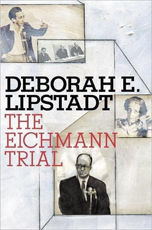Lipstadt shows insightful opinions in ‘The Eichmann Trial’
Published May 4, 2011
Who would have thought that when Adolph Eichmann stood trial in Israel for crimes against the Jewish people, the “gallery” would have at any time “erupted with laughter?” In her most recent book “The Eichmann Trial” (Random House, $24.95), Deborah Lipstadt, who teaches Holocaust history at Emory University, in fact captures an instance of grim amusement.
Eichmann’s attorney was giving him opportunity to defend his written order that the trains – with capacity for 700 persons – used to deport Jews (to concentration camps or death camps) were to be loaded with a minimum of 1,000 people. There was derisive laughter when the defendant explained: The original calculation applied to soldiers traveling with baggage; there was room for 300 extra people, because the Jews’ baggage was being transported separately.
Lipstadt devotes a whole, somewhat convoluted chapter to Hannah Arendt, a contradictory personality and German-Jewish émigré who covered the trial for The New Yorker. During a 2010 book talk in St. Louis, Neal Bascomb, author of “Hunting Eichmann,” criticized Arendt’s spotty attendance in Jerusalem and spoke passionately against her generally controversial conclusion that Eichmann was an obedient “cog” and a prime sample of “the banality of evil.”
After Israeli agents captured Eichmann in Buenos Aires they found a “trembling factory worker with dentures and shabby underwear.” But this – like his befuddlement while testifying ( for instance, about trains) – could not contradict the evidence. In 1932 at age 26, Eichmann joined the Nazi party and shortly after, the SS. At first he held responsibilities in low-level intelligence, for instance, summarizing Zionist pamphlets. But he evolved into a zealous “desk murderer” eager for recognition from his superiors. In country after country, he had been head of operations for the roundup and deportation of every last possible Jew. He was not just a cog following orders. In Hungary in 1944, in a desperate attempt to empty the nation’s Jews before the Russians arrived, Eichmann set up death marches to Austria.
When Prime Minister David Ben-Gurion announced to the Knesset that the alleged Nazi murderer had been captured and was already imprisoned in Israel, Israelis exulted. “Eichmann b’yadenu!” Eichmann is in our hands!
But the Washington Post, the New York Times, Time magazine, Christian Science Monitor and others were united in denunciation of the Israelis. In the National Review, William Buckley felt compelled to write three editorials on the subject. He said the Israelis’ “pernicious” action was typical of the Jewish “refusal to forgive” and that the Jewish people on whose behalf it was taken was a “mythical legal identity.”
With some thought to the world stage, and in association with staff at Yad Vashem, the prosecutor, Gideon Hausner, inaccurately painted Eichmann as a mastermind of all elements of the Final Solution. While a corps of survivors testified, some without direct connection to the defendant, the judges sometimes questioned the relevance of these witnesses to the case.
But an unpredicted effect of the trial is that, at least in Israel, it exonerated survivors. Most notably, when the prosecutor asked survivor, Moshe Beisky, why the 15,000 prisoners forced at gunpoint by the SS to watch a boy being hanged did not rise up against their wardens? Beisky sank onto a chair to explain the hopeless situation. If anyone struck out against the Nazis or escaped he could count on massive reprisals against other inmates. And with a shaved swath down the center of his head and dressed in yellow and blue striped pajamas, where was anyone to go?
Lipstadt’s book is compact, but a little disorganized in its exposition. The publication may have been rushed to fall near the 50th anniversary of the trial’s opening date, April 11, 1961. Nevertheless, it is frequently insightful for the current generation of readers, about the storm the trial at first generated and the climate of opinion it left in its wake.















